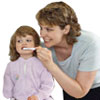‘Dental’ as anything: Dental health for kids
Babies and young children naturally lose their primary teeth, but that’s no excuse for delaying good dental hygiene. Healthy children’s teeth are an important foundation for future health. Obviously children need good teeth to chew, but they also need their primary teeth to ensure good speech development, and to ensure the permanent teeth can form properly, in the correct position. We also want our kids to feel good about their little smiles – because if they’re smiling, so are we.
Caring for caries
Keeping children’s teeth healthy sounds pretty easy. Indeed, maintaining healthy teeth is a simple matter of maintaining good dental hygiene through brushing teeth regularly. However, childhood caries, or ‘baby bottle decay’, are actually the most common chronic childhood health problem.
Early childhood caries can develop as soon as a baby’s teeth emerge. Tooth decay, which often appears as white spots or lines on the front teeth, can sometimes be seen as early as 10 months.
Parents who notice white lines or spots on their children’s teeth should take their child to the dentist immediately. White spots may indicate something other than tooth decay, but if they are due to tooth decay, they need to be treated by a dentist immediately. Left untreated, the spots may turn yellowish-brown and the decay often spreads to the back teeth, where it appears as black holes.
Of course, prevention is better than the cure, and a good dental hygiene routine can prevent tooth decay. No matter what age your child, regular cleaning of teeth and gums is important.
Gummy Bears: How to look after teeth your baby’s teeth
For babies 0–6 months old
You must clean your baby’s gums every day, so here’s a couple of tips:
- Cradle your child with one arm; and
- Wrap a moistened gauze square or washcloth around the index finger of your other arm and gently massage the teeth and gingival tissues; or
- Introduce a soft-bristled toothbrush during this age, only if you feel comfortable using the toothbrush, and do not use toothpaste.
For toddlers 6–18 months old
For toddlers, you can transition to a toddler toothbrush with a small head and soft, rounded bristles. Teeth should be brushed or cleaned twice a day – morning and evening. Up to the age of 18 months, the teeth should be brushed with plain water. Toothpastes containing fluoride should not be used, as their use can lead to excessive fluoride intake, which may result in fluorosis (an unattractive mottling of the teeth).
Early childhood 18 months to 6 years
There are special low-fluoride toothpastes developed for children, with half the amount of fluoride as adult toothpaste. These can be introduced from the age of 18 months. Only use a pea-sized smear of toothpaste. It’s also a good idea to supervise teeth cleaning to make sure your li’l gremlin doesn’t swallow the toothpaste!
At about 4 or 5 years, kids should start learning how to brush their own pearlies. You will still need to help them until about 8 years old, so here’s some more tips:
- Move the toothbrush gently in small circles to clean all surfaces of the teeth. Avoid side-to-side scrubbing, which can damage teeth and gums;
- Electric toothbrushes, which rotate and oscillate, can be used – make sure the brush head is small enough for their mini-mouths!
- Aim to brush for about two minutes – with patience, your child will soon learn to tolerate it; and
- Toothbrushes should be replaced every 3 months (if used properly).
Don’t forget to get them in the habit of flossing from an early age. The Australian Dental Association recommends flossing from two and a half years old. It can be done daily but, at a minimum, at least twice a week.
For the discerning brusher …
If your toddler resists brushing or cannot sit still for two minutes, try these suggestions:
- Consider a battery-powered brush, which adds novelty to cleaning teeth;
- Sing nursery rhymes or play a favourite song while you help your child brush their teeth;
- Offer a reward (either non-food or low fat/sugar snacks, such as celery or carrot sticks) every time your toddler allows you to brush for two minutes;
- Make flossing and brushing as much fun as you can to avoid any negative association or resistance. Talk to your dentist if you need advice.
Kids also take after their parents, so if you brush your teeth and make regular visits to your dentist, then your child will be more inclined to follow this behaviour. Speaking of the dentist, it doesn’t need to be a nightmare. It’s recommended that the first check-up be about 6 months after the first teeth come through – and don’t wait after 12 months of age. The sooner you take them, the more natural it will become.
Key points to boost the brush
- Once the baby or primary teeth start to appear, use a baby’s toothbrush with a small head and soft, rounded bristles, because small mouths need small brushes;
- Up to the age of 18 months, the teeth should be brushed with plain water. Preferably, teeth should be brushed twice a day – morning and evening;
- You can use low-fluoride children’s toothpaste after 18 months of age;
- Store all toothpaste away from little hands, because some kids may love the taste and eat it if they can;
- Kids should be brushing by about 8 years old with your help, and then on their own at about 10 years of age;
- Daily flossing can start at about 2 and half years old;
- Don’t forget to visit the dentist; and
- Lastly, set a good example as a parent or guardian and look after your own chompers!
More information
 | For more information, see Dental Health in Infancy to Early Childhood.
|
Dates
Tags
Created by:

 Login
Login














